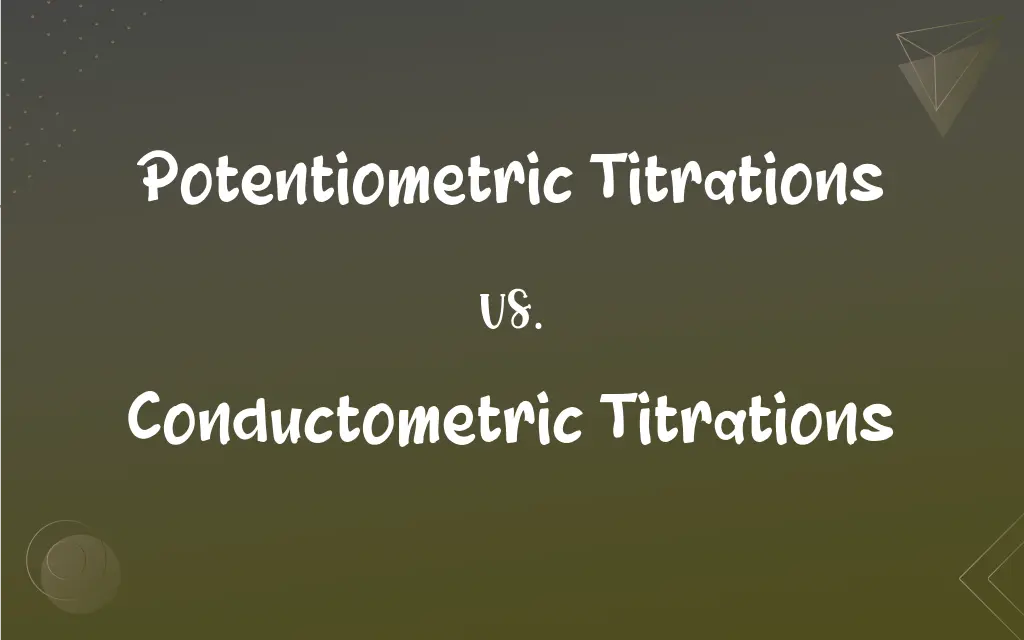Potentiometric Titrations vs. Conductometric Titrations: What's the Difference?
By Harlon Moss & Janet White || Published on March 15, 2024
Potentiometric titrations measure voltage changes to find the endpoint, focusing on the analyte's concentration, while conductometric titrations track conductivity variations, relying on the ionic movement and concentration.

Key Differences
Potentiometric and conductometric titrations are analytical techniques used to determine the concentration of an analyte in a solution. Potentiometric titrations involve measuring the potential (voltage) difference between two electrodes as a reaction progresses, with the endpoint identified by a sharp change in voltage. This method is particularly useful for reactions involving ions that change their oxidation state or participate in acid-base reactions. Conductometric titrations, on the other hand, measure the electrical conductivity of the solution, which changes as the ionic composition of the solution changes during the titration. This method is effective for reactions where the conductivity significantly changes upon reaching the endpoint.
The equipment and setup for these titrations differ significantly. Potentiometric titrations require a sensitive voltmeter or pH meter connected to appropriate electrodes, typically a reference electrode and an indicator electrode that is sensitive to the analyte's ion. Conductometric titrations use a conductivity meter with two electrodes to measure the solution's conductivity.
Potentiometric titrations are highly specific, as the choice of electrode can be tailored to the analyte of interest, making them suitable for complex mixtures or where specific ion concentration is to be determined. Conductometric titrations are generally less specific and may be influenced by all ions present in the solution, making them more suitable for simple systems or where the total ionic strength changes significantly at the endpoint.
The sensitivity and precision of potentiometric titrations are typically higher than those of conductometric titrations, as the potential change at the endpoint can be very distinct. However, conductometric titrations are simpler and faster, offering advantages in terms of ease of use and the need for less sophisticated equipment.
Both methods have their applications based on the nature of the analyte and the reaction. Potentiometric titrations are widely used in acid-base, complexation, and redox reactions, especially where precise quantification is needed. Conductometric titrations are preferred for strong acid-strong base, strong acid-weak base, or precipitation reactions, where the change in conductivity is marked and easily detected.
ADVERTISEMENT
Comparison Chart
Measurement
Voltage (potential difference)
Conductivity
Endpoint Detection
Sharp change in voltage
Significant change in conductivity
Specificity
High, with specific electrodes for different analytes
Lower, influenced by all ions present
Applications
Acid-base, redox, complexation reactions
Strong acid-base, precipitation reactions
Equipment
Voltmeter/pH meter, specific electrodes
Conductivity meter, generic electrodes
ADVERTISEMENT
Sensitivity and Precision
Higher, due to specific endpoint detection
Generally lower, but adequate for certain reactions
Suitability
Complex mixtures, specific ion concentration measurements
Simple systems, total ionic strength changes
Potentiometric Titrations and Conductometric Titrations Definitions
Potentiometric Titrations
Determines analyte concentration via voltage changes.
The pH meter in acid-base titrations.
Conductometric Titrations
Tracks ionic movement and concentration.
Monitoring the reaction between sodium hydroxide and hydrochloric acid.
Potentiometric Titrations
Tailored electrodes for different ions.
Silver electrode for chloride ion analysis.
Conductometric Titrations
Preferred for quick analyses.
Industrial wastewater treatment monitoring.
Potentiometric Titrations
Ideal for complex solutions.
Quantifying lead ions in environmental samples.
Conductometric Titrations
Effective in straightforward reactions.
Titrating a strong acid against a strong base.
Potentiometric Titrations
Sharp voltage change indicates completion.
Detection of the equivalence point in redox titrations.
Conductometric Titrations
General electrodes for conductivity.
Platinum electrodes in conductometric setups.
Potentiometric Titrations
Broad use across chemical analyses.
Measuring vitamin C content in fruit juices.
Conductometric Titrations
Marked shift signals completion.
Precipitation titration of silver nitrate with chloride.
FAQs
Are there reactions where both titration methods could be effectively used?
Yes, for some reactions, like a strong acid with a strong base, both methods can effectively determine the endpoint, with the choice depending on the desired specificity, equipment availability, and convenience.
What distinguishes potentiometric from conductometric titrations?
The main difference lies in the detection method: potentiometric titrations measure voltage changes, while conductometric titrations measure conductivity changes.
How do you choose between potentiometric and conductometric titrations?
The choice depends on the analyte's properties, the reaction type, and the required precision and specificity of the measurement.
Can potentiometric titrations be used for all types of reactions?
While versatile, they are best suited for reactions where the analyte or titrant causes a significant potential change, such as in acid-base or redox reactions.
Why are conductometric titrations considered less specific?
Because they measure the overall conductivity, which can be influenced by all types of ions present, not just the ions of interest.
How does the presence of multiple ions in a solution affect potentiometric and conductometric titrations?
In potentiometric titrations, the presence of multiple ions may require more selective electrodes to specifically target the ion of interest, whereas in conductometric titrations, multiple ions can affect the overall conductivity measurement, potentially complicating the identification of the endpoint unless the reaction significantly alters the ionic strength or composition.
Can temperature affect the outcomes of potentiometric and conductometric titrations?
Yes, temperature can significantly impact both methods. For potentiometric titrations, temperature changes can affect the electrode potential and the equilibrium constants of the reactions. In conductometric titrations, temperature variations can alter the conductivity of the solution, as ionic mobility changes with temperature.
What are the limitations of conductometric titrations?
Conductometric titrations may not be suitable for reactions that do not significantly change the solution's conductivity or for systems where multiple ions contribute to conductivity, making it difficult to clearly identify the endpoint.
Can potentiometric titrations be automated?
Yes, potentiometric titrations can be automated with the use of automatic titrators and software that can precisely control the addition of titrant and record voltage changes, improving efficiency and reproducibility.
What is the impact of electrode maintenance on potentiometric titration accuracy?
Regular maintenance and calibration of electrodes are essential to ensure their proper functioning and accuracy in potentiometric titrations. Neglected electrodes can lead to drift, slow response times, and inaccurate measurements.
What role does pH play in potentiometric titrations?
pH plays a crucial role in potentiometric titrations, especially in acid-base reactions, as it directly affects the potential measured by pH-sensitive electrodes, allowing for the determination of the analyte concentration based on the observed pH changes.
How do analysts handle weak acid-weak base titrations using these methods?
Weak acid-weak base titrations can be challenging due to the less distinct endpoint changes. Potentiometric titrations, using pH or ion-selective electrodes, can provide more precise endpoints by detecting subtle potential changes. Conductometric titrations may not be as effective for these titrations due to the smaller changes in conductivity.
How do analysts interpret titration curves from both methods?
In potentiometric titrations, analysts look for a sharp potential change on the titration curve to identify the endpoint. In conductometric titrations, the endpoint is identified by a pronounced change in the slope of the conductivity versus volume of titrant added curve.
What role does the electrode play in the accuracy of potentiometric titrations?
The choice and condition of the electrode are crucial for accuracy in potentiometric titrations. Electrodes must be selective for the analyte of interest and properly maintained to ensure reliable and reproducible measurements.
What safety considerations should be taken into account during these titrations?
Safety considerations include proper handling and disposal of chemicals, ensuring that the titration apparatus is set up correctly to avoid spills or leaks, and using appropriate personal protective equipment (PPE) to protect against exposure to hazardous substances.
How does the ionic strength of the solution affect conductometric titrations?
The ionic strength of the solution can significantly impact the conductivity measurements in conductometric titrations, as it affects the mobility of ions. Adjustments or considerations may need to be made for solutions with high ionic strength to accurately interpret the results.
Can both titration methods be used in quality control processes?
Yes, both potentiometric and conductometric titrations are used in quality control processes across various industries, including pharmaceutical, food and beverage, and chemical manufacturing, to ensure product consistency and compliance with standards.
Is one method faster than the other?
Conductometric titrations can be faster as they generally require less preparation and calibration of equipment compared to potentiometric titrations, which may require more time to select and calibrate specific electrodes for the analyte of interest.
What advancements have been made in potentiometric and conductometric titration techniques?
Recent advancements include the development of more selective and sensitive electrodes for potentiometric titrations, and improvements in conductivity measurement technology for conductometric titrations, enhancing their accuracy, sensitivity, and applicability to a wider range of samples and reactions.
How do these titration methods contribute to environmental analysis?
Both methods are valuable in environmental analysis for determining the concentration of pollutants in water and soil samples. Potentiometric titrations are useful for specific ion detection, while conductometric titrations can be used for assessing overall ionic content changes related to pollution.
About Author
Written by
Harlon MossHarlon is a seasoned quality moderator and accomplished content writer for Difference Wiki. An alumnus of the prestigious University of California, he earned his degree in Computer Science. Leveraging his academic background, Harlon brings a meticulous and informed perspective to his work, ensuring content accuracy and excellence.
Co-written by
Janet WhiteJanet White has been an esteemed writer and blogger for Difference Wiki. Holding a Master's degree in Science and Medical Journalism from the prestigious Boston University, she has consistently demonstrated her expertise and passion for her field. When she's not immersed in her work, Janet relishes her time exercising, delving into a good book, and cherishing moments with friends and family.







































































